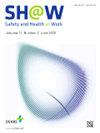Development of Korean CARcinogen EXposure: IARC Group 2A Carcinogens
IF 2.9
3区 医学
Q1 PUBLIC, ENVIRONMENTAL & OCCUPATIONAL HEALTH
引用次数: 0
Abstract
Backgrounds
Reliable exposure data are critical for occupational cancer prevention and epidemiological studies. We developed the Korean CARcinogen EXposure (K-CAREX) to provide exposure prevalence and intensity for 20 carcinogens classified as Group 1 by the International Agency for Research on Cancer (IARC). This study extends K-CAREX to include IARC Group 2A agents.
Methods
National data sources, including the Work Environment Measurement Database (WEMD), Special Health Examination Database (SHED), and Work Environment Condition Survey (WECS), provided basic exposure data. A stepwise estimation approach was employed to refine exposure prevalence estimates by industry, derived from the WEMD, SHED, and WECS. WEMD was used to estimate exposure intensity by industry, whereas SHED was used to assess exposure prevalence by occupation. Matched data, representing workers who wore samplers and underwent health examinations for the same carcinogen in the same year, were used to estimate exposure intensity by occupation.
Results
A total of 18 IARC Group 2A agents were included. Exposure prevalence was estimated for all 18 carcinogens by industry, and exposure intensity was estimated for 16. The number of exposed workers was estimated, with 162,153 workers exposed to lead, for example. Exposure prevalence and intensity were also assessed for 18 and 16 carcinogens, respectively, by occupation.
Conclusion
The K-CAREX database was developed to estimate exposure prevalence and intensity by industry and occupation for 18 IARC Group 2A agents. These findings provide valuable data for cancer prevention and epidemiological studies. Future work may expand K-CAREX to include IARC Group 2B agents and other carcinogenic agents.
韩国致癌物暴露的发展:IARC 2A组致癌物
背景:可靠的暴露数据对职业性癌症的预防和流行病学研究至关重要。我们开发了韩国致癌物暴露(K-CAREX),以提供被国际癌症研究机构(IARC)分类为第一类的20种致癌物的暴露率和强度。本研究将K-CAREX扩展到IARC 2A组药物。方法通过工作环境测量数据库(WEMD)、特殊健康检查数据库(SHED)和工作环境状况调查(WECS)等国家数据来源提供基本暴露数据。根据WEMD、SHED和WECS,采用逐步估计方法来细化各行业的暴露率估计。WEMD被用来估计不同行业的暴露强度,而SHED被用来评估不同职业的暴露发生率。匹配的数据代表了在同一年佩戴了采样器并接受了同一致癌物健康检查的工人,这些数据被用于按职业估计暴露强度。结果共纳入18种IARC 2A组药物。对所有18种致癌物的工业暴露率进行了估计,对16种致癌物的暴露强度进行了估计。据估计,受铅污染的工人人数为162153人。还分别按职业评估了18种和16种致癌物的暴露率和暴露强度。结论建立了K-CAREX数据库,用于估计18种IARC 2A组毒剂的行业和职业暴露率和暴露强度。这些发现为癌症预防和流行病学研究提供了有价值的数据。未来的工作可能会将K-CAREX扩展到包括IARC 2B类药物和其他致癌药物。
本文章由计算机程序翻译,如有差异,请以英文原文为准。
求助全文
约1分钟内获得全文
求助全文
来源期刊

Safety and Health at Work
Social Sciences-Safety Research
CiteScore
6.40
自引率
5.70%
发文量
1080
审稿时长
38 days
期刊介绍:
Safety and Health at Work (SH@W) is an international, peer-reviewed, interdisciplinary journal published quarterly in English beginning in 2010. The journal is aimed at providing grounds for the exchange of ideas and data developed through research experience in the broad field of occupational health and safety. Articles may deal with scientific research to improve workers'' health and safety by eliminating occupational accidents and diseases, pursuing a better working life, and creating a safe and comfortable working environment. The journal focuses primarily on original articles across the whole scope of occupational health and safety, but also welcomes up-to-date review papers and short communications and commentaries on urgent issues and case studies on unique epidemiological survey, methods of accident investigation, and analysis. High priority will be given to articles on occupational epidemiology, medicine, hygiene, toxicology, nursing and health services, work safety, ergonomics, work organization, engineering of safety (mechanical, electrical, chemical, and construction), safety management and policy, and studies related to economic evaluation and its social policy and organizational aspects. Its abbreviated title is Saf Health Work.
 求助内容:
求助内容: 应助结果提醒方式:
应助结果提醒方式:


